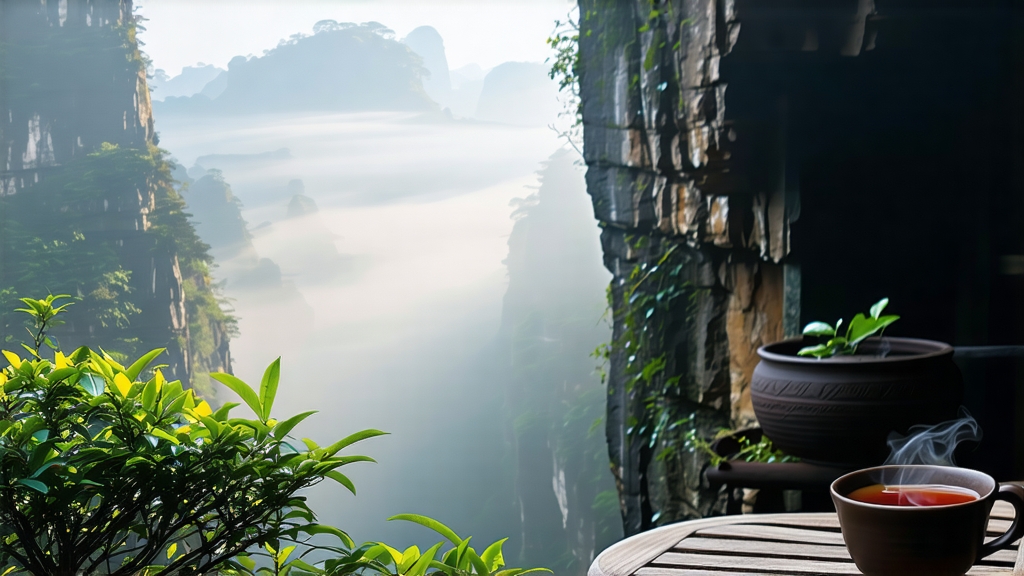
If green tea is the fresh-faced youth of Chinese tea and pu-erh the wise elder, then Da Hong Pao sits magisterially in between—an oolong of middle age, burnished by fire, carved by stone, and wrapped in legend. Known in the West as “Big Red Robe,” this most celebrated of Wuyi yancha (rock teas) carries the scent of pine-smoked cliffs and the taste of liquid minerals. To understand it is to step into the misty gorges of northern Fujian where basalt pillars rise above the Nine-Bend River and every leaf seems to remember the Ming dynasty.
Origin Myth & Imperial Threads
The name first appears in Ming-era county annals, but the story every local guide loves to tell happened during the reign of the Wanli Emperor. A Ming scholar, en route to the capital for imperial exams, fell ill at the foot of Tianxin Rock. Monks from the nearby Yongle Temple brewed leaves picked from three bushy old trees that clung to a cleft in the cliff. The traveler revived, continued north, and later returned in triumph wearing the crimson robe of first-rank officials. To express gratitude he draped the robe over the tea trees; the vermilion cloth bled into the bark, and the tea forever after bore the color and name. Whether allegory or marketing genius, the tale cemented Da Hong Pao’s reputation as tea fit for emperors. In 1972 Mao Zedong presented 50 grams of the original mother-tree harvest to U.S. President Nixon, quietly signaling diplomacy steeped in Wuyi terroir.
Mother Trees & Modern Clones
Only six original “mother trees” still survive on the 300-meter-high Jiulong Ke cliff, now protected by UNESCO and fenced off since 2006 when picking was officially halted. Genetic fingerprinting shows they represent three distinct cultivars: Qi Dan, Bei Dou, and Que She. Cuttings taken in the 1980s produced garden populations collectively labeled “pure-clone Da Hong Pao,” while skilled blenders also marry selected yancha cultivars—Rou Gui for spice, Shui Xian for orchid depth, Tie Luo Han for structure—to recreate the “mother tree” cup profile. Thus the market offers three tiers:
- Mother-tree tea (pre-2006, auction only, USD 30,000 per 20 g).
- Pure-clone single-garden (harvests from genetically verified clonal gardens).
- Blended “commodity” grade (skillfully balanced but affordable daily drink).
Terroir: When Rock Becomes Flavor
Wuyi’s Danxia landform weathers into mineral-rich, gravelly soil that drains rapidly yet retains heat. Day-night temperature differentials of 15 °C slow leaf growth, condensing aromatics. Constant low cloud raises humidity, allowing the tea plant to absorb moisture through leaf pores, effectively “drinking” the mist. Local tasters speak of yanyun—“rock rhyme”—a tactile vibration felt at the back of the throat, like licking wet slate. Chemically, high levels of trace elements (especially potassium and magnesium) translate into heightened polyphenol complexity, while the stressed environment boosts salivary lactones responsible for lingering sweetness.
Pluck & Wither: The First Breath of Transformation
Standard picking window is late April to early May, when three half-mature leaves and a bud open like a bird’s claw. Leaves are spread 3 cm thick on bamboo trays set into the cliff-shadowed courtyard; intermittent mountain breezes reduce moisture from 75 % to about 65 % within two hours, softer than lowland oolongs that rely on strong sun. This gentle wither preserves long-chain aromatics that later manifest as peach skin and narcissus.
Shaking & Wounding: The Dance of Enzymes
Every forty minutes the master “shakes green” in a rattan drum rotating at 18 rpm—slow enough to bruise leaf edges without cracking the center. Oxidation proceeds asymmetrically: cut edges redden to 30 % while the vein stays green, creating the “green leaf with red border” hallmark. Ambient temperature is held at 23 °C; higher and the tea tips toward black, lower and it remains too vegetal. Judgment is sensory: when crushed leaves smell of ripe apricot and copper pennies, oxidation halts.
Kill-Green: Charcoal vs Electric
Traditionalists insist on 280 °C wok firing for 90 seconds, hand-tossing